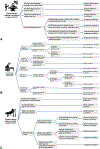Allergy Safety Events in Health Care: Development and Application of a Classification Schema Based on Retrospective Review
- PMID: 35398557
- PMCID: PMC9371622
- DOI: 10.1016/j.jaip.2022.03.026
Allergy Safety Events in Health Care: Development and Application of a Classification Schema Based on Retrospective Review
Abstract
Background: Allergy safety requires understanding the operational processes that expose patients to their known allergens, including how and when such processes fail.
Objective: To improve health care safety for patients with allergies, we developed and assessed an allergy safety event classification schema to describe failures resulting in allergy-related safety events.
Methods: Using keyword searches followed by expert manual review of 299,031 voluntarily-filed safety event reports at 2 large academic medical centers, we identified and classified allergy-related safety events from 5 years of safety reports. We used driver diagrams to elucidate root causes for commonly observed allergy safety events in health care settings.
Results: From 299,031 safety reports, 1922 (0.6%) were extracted with keywords and 744 (0.2%) were manually confirmed as allergy-related safety events. Safety failures were due to incomplete/inaccurate electronic health record documentation (n = 375, 50.4%), human factors (n = 175, 23.5%), allergy alert limitation and/or malfunction (n = 127, 17.1%), data exchange and interoperability failures (n = 92, 12.4%), and electronic health record system default options (n = 30, 4.0%). Safety failures resulted in known allergen exposures to drugs (n = 537), including heparin (n = 27) and topical anesthetics such as lidocaine (n = 8); latex (n = 114); food allergens (n = 73); and adhesive (n = 23).
Conclusions: We identified 744 allergy-related safety events to inform a novel safety failure classification schema as an important step toward a safer health care environment for patients with allergies. Improved systems are required to address safety issues with certain food and drug allergens.
Keywords: Allergy safety hazard/failure; Drug allergy; Food allergy; Patient safety.
Copyright © 2022 American Academy of Allergy, Asthma & Immunology. Published by Elsevier Inc. All rights reserved.
Conflict of interest statement
Conflicts of interest: N. A. Phadke reports spousal employment by Chiesi Farmaceutici, L. Zhou reports grants from CRICO during the conduct of this study, and K. G. Blumenthal reports grants from the National Institutes of Health, Massachusetts General Hospital, and the American Academy of Allergy, Asthma, and Immunology during the conduct of this study as well as a copyright for a decision support tool for β-lactam allergy licensed to Persistent Systems. The rest of the authors declare that they have no relevant conflicts of interest.
Figures



Similar articles
-
Improving Allergy Documentation: A Retrospective Electronic Health Record System-Wide Patient Safety Initiative.J Patient Saf. 2022 Jan 1;18(1):e108-e114. doi: 10.1097/PTS.0000000000000711. J Patient Saf. 2022. PMID: 32487880 Free PMC article.
-
Development of a code system for allergens and its integration into the HL7 FHIR AllergyIntolerance resource.Int J Med Inform. 2025 Mar;195:105739. doi: 10.1016/j.ijmedinf.2024.105739. Epub 2024 Nov 30. Int J Med Inform. 2025. PMID: 39626595
-
Clinical Decision Support Systems for Drug Allergy Checking: Systematic Review.J Med Internet Res. 2018 Sep 7;20(9):e258. doi: 10.2196/jmir.8206. J Med Internet Res. 2018. PMID: 30194058 Free PMC article.
-
A dynamic reaction picklist for improving allergy reaction documentation in the electronic health record.J Am Med Inform Assoc. 2020 Jun 1;27(6):917-923. doi: 10.1093/jamia/ocaa042. J Am Med Inform Assoc. 2020. PMID: 32417930 Free PMC article.
-
The forensic implications of food hypersensitivity - a review of cases in United Kingdom courts: January 2014-February 2020.Perspect Public Health. 2022 Nov;142(6):347-354. doi: 10.1177/17579139221136723. Perspect Public Health. 2022. PMID: 36458486 Free PMC article. Review.
Cited by
-
A scoping review of rule-based clinical decision support malfunctions.J Am Med Inform Assoc. 2024 Oct 1;31(10):2405-2413. doi: 10.1093/jamia/ocae187. J Am Med Inform Assoc. 2024. PMID: 39078287 Free PMC article.
-
Latex Allergy - From Discovery to Component-resolved Diagnosis.Endocr Metab Immune Disord Drug Targets. 2024;24(5):541-548. doi: 10.2174/1871530323666230901102131. Endocr Metab Immune Disord Drug Targets. 2024. PMID: 37680164 Review.
References
-
- American Hospital Association. Fast facts on U.S. hospitals, 2021. Accessed March 17, 2021. https://www.aha.org/statistics/fast-facts-us-hospitals
-
- Corrigan JM, Kohn LT, Donaldson MS, editors. To Err Is Human: Building a Safer Health System. Washington, DC: Institute of Medicine; 2000. - PubMed
Publication types
MeSH terms
Substances
Grants and funding
LinkOut - more resources
Full Text Sources
Medical

